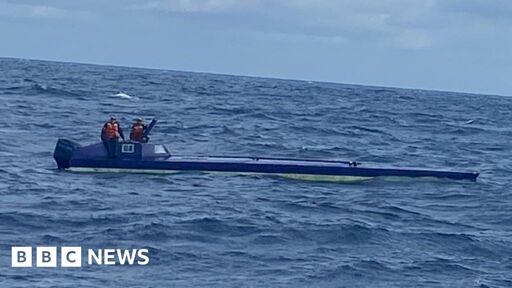Summary
The Colombian navy intercepted a semi-submersible carrying cocaine in the Pacific, uncovering a new smuggling route to Australia.
The vessel, capable of traveling thousands of miles without refueling, was part of a lucrative operation targeting Australia, where cocaine fetches six times the U.S. price.
This was the third such vessel seized, with maps confirming the route.
The operation, part of the multinational “Orion” initiative, seized 225 tonnes of cocaine and arrested over 400 people globally.
Colombian authorities highlighted links between South American and Oceanian crime networks.



"Acute, short-lived reactions are often fairly benign, whereas chronic, unremitting courses carry a poor prognosis. Delayed, intermittent phenomena (“flashbacks”) and LSD-precipitated functional disorders that usually respond to treatment appropriate for the non-psychedelic-precipitated illnesses they resemble, round out this temporal means of classification. The question of organic brain damage as well as permanent changes in personality, attitudes, and creativity in patients and normals who have repeatedly ingested psychedelic drugs is controversial, but tends to point to subtle or nonsignificant changes. Future areas for study of the psychedelics’ pharmacological, psychological, and therapeutic effects are suggested. "
which is from this scientific paper: https://journals.lww.com/jonmd/citation/1984/10000/adverse_reactions_to_psychedelic_drugs__a_review.1.aspx
Claiming that flashbacks “is not evidence-based”, as you claim, is pseudoscientific disinformation, according to that paper’s abstract.
Case closed.
_ /\ _
deleted by creator
Just to review, your arguments that I’m labeling as non-evidence-based are:
You chose to quote an abstract from a 40-year-old lit review, and even though it doesn’t support your point, you’re declaring this “case closed.” You’re either arguing in bad faith or you’re not putting much effort into finding the truth. Either way I think you know your case is weak.
Strassman is summarizing the range of post-LSD experiences that have been reported. Delayed, intermittent psychosis is at one end of the range and mild, short-term symptoms at the other. He doesn’t validate those reports, and goes on to say that no causal relationship had been established, and the etiology of “flashbacks” was at that time controversial.
A more recent 2021 review by David Nutt et al. (Nutt is by most accounts the most credentialed and respected psychedelic researcher today) says:
I will say again that your original arguments are not supported by current research. I won’t spend any more time debating this with you because we don’t seem to have the same definitions of “evidence” and “misinformation.”